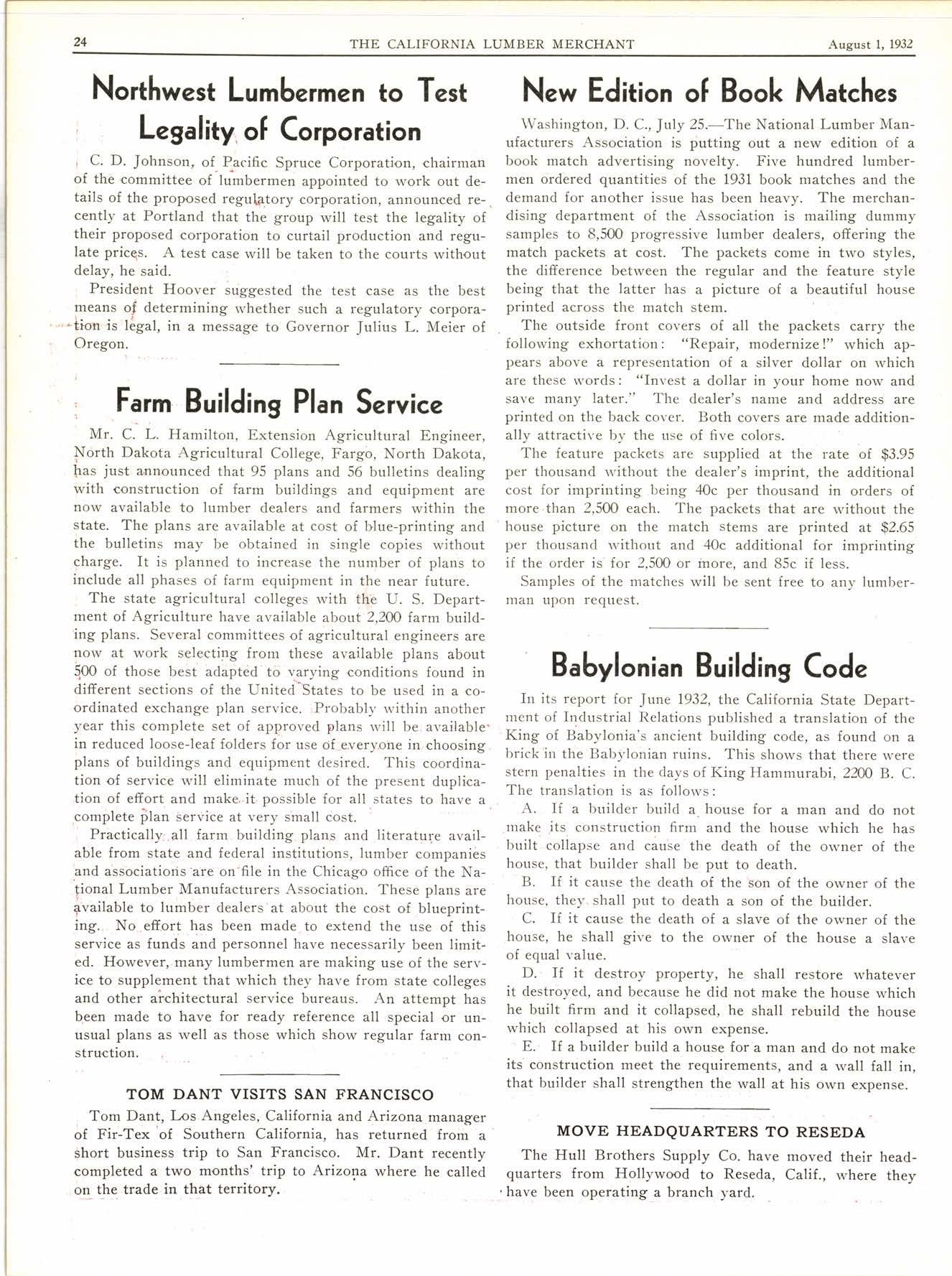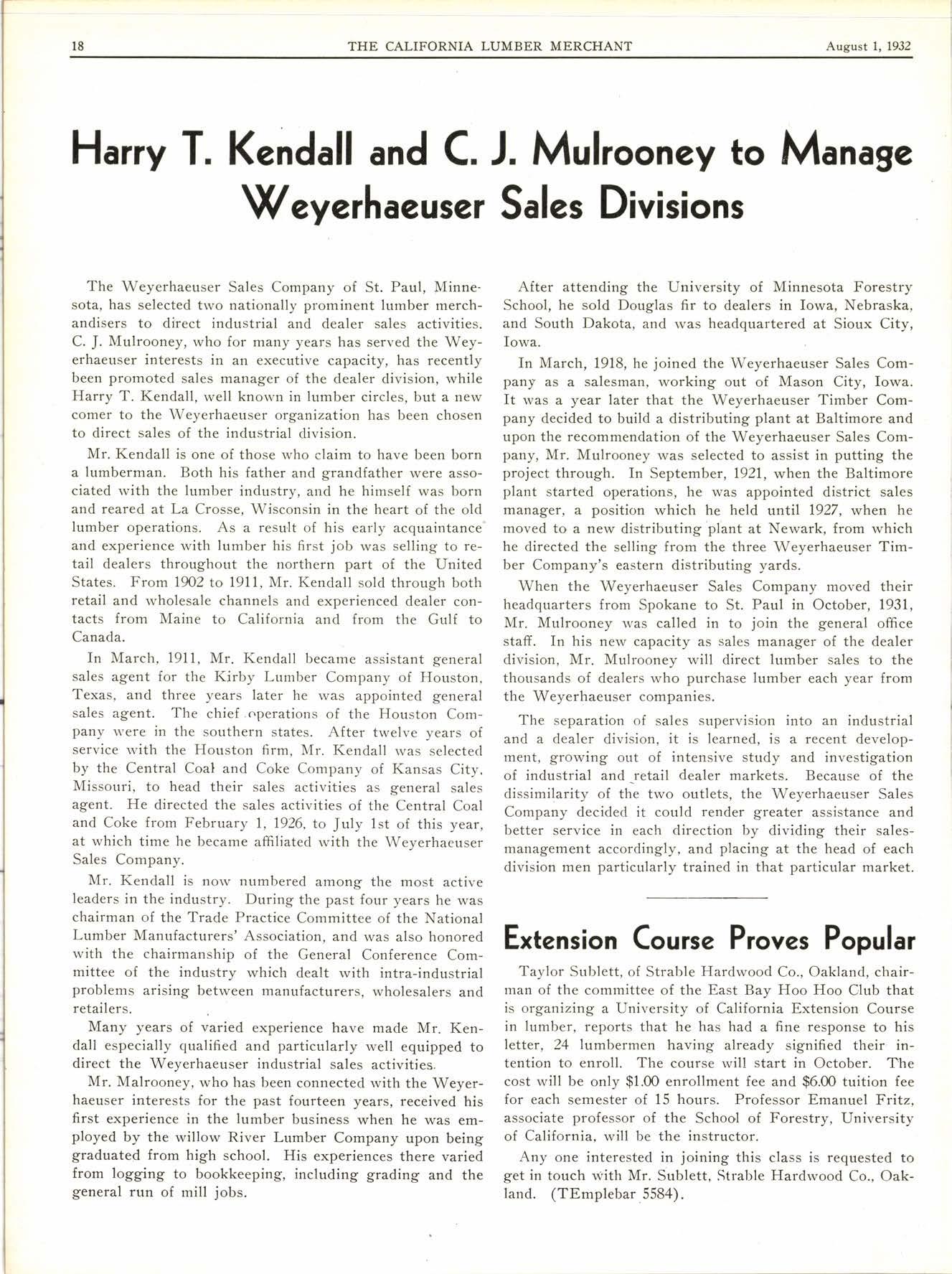
4 minute read
Fabricated Cottages House Athletes for Olympic Games
Olympic Village with its 550 cottages of similar design is now housing over 200O men athletes representing over 50 nations who will compete in the 1932 Olympic games to bei held at Los Angeles, July 30 to August 14. The village is built on a 331 tract of land in Baldwin Hills on a high mesa overlooking the city of Los Angeles. The village is a ten minutes drive by automobile from the Olympic stadium where many of the events will be held.
With the clearing of the ground, the land was ploughecl and rolled, four miles of water mains were put in and ten miles of hard packed roads plotted out. This work done, the ground was ready for the setting up of the 550 houses, each to accommodate four athletes.
The houses were furnished by the E. K. Wood Lumber Co. of Los Angeles. The many lumber items were manufactured and fabricated into the various house units at their plant, then transported to the village in trucks where the units were assembled by bolts and log screws. Insulite was used for the roofs and sidewalls of the houses. It required three men about four hours to assemble a house.
The cottages are 10 by 24 feet in dimension and consist of two rooms, with a hallway leading into ea,ch room. Each house has a por'ch. With the exception of the ridge poles used for the roofs, short length lumber not exceeding ten feet was used. Approximately 1740 feet of lumber was used in each building including the porch ancl floor, and about
1200 square feet of Insulite was required for each house. The houses are provided with a shower, lavatory, and clothes closet and are also equipped with specially built beds and furniture.
Other buildings on the area include the large 60O foot administration building which forms a distinctive entrance to the village, dining halls, kitchens, bathing houses, hospital, post office, press building, theatre, canteen, etc.
Lawns have been made in all available spaces and flowers, shrubery and palm trees growing everywhere add to the beauty of the village. Each cottage has been so placed that the front porch commands an excellent view of Los Angeles, Hollywood and the Beaches. And the layout of the houses have been so planned that the representatives of similar nations are grouped together. In fact, nothing has been overlooked for the comfort of the athletes and the bovs are enjoying all the comforts of home.
The village is completely surrounded by a high wire fence and a regular crew of fence riders patrol the fence both day and night.
At the expiration of the g'ames, the Olympi'c cottages will be sold which simply means the unbolting of the various house sections to be reassembled again on their new location. Reports are that to date more than half the cottages have been sold-just a matter of "knock 'em down and drag'em out."
U. S. Exports of Oak lor 1931 Commercial Standard for Fibre
The value of United States exports of oak lumber and cooperage for 1931 was $12,272.000; a third less than the amount for 1930 which was $18,585,000. The biggest item was boards, planks and scantlings, which comprised twothirds of the value. Staves and shooks amounted to $3,000,000.
Oak is the third ranking United States export species, Southern pine and Douglas fir leading by far in quantity and usually by a considerable excess in value. In 1931 oak quantities were still much below those of the two leading softwoods, but combined values of oak lumber, except small dimension, and of tight ,cooperage, ran a pretty 'close race with export values for logs, lumber, sawn timber and box shooks of Southern pine or of Douglas fir.
The United Kingdom was the best market for exports of oak lumber; Canada next, then Belgium, Netherlands, France and Argentine.
7+YEAR-OLD SHINGLE
A shingle which had been in continuous use for 74 yearc and is still in good condition, won a prize offered at the Oregon State Fair by the Willamette lumber Dealers' Institute. The winning shingle was exhibited by S. E. Brown, of Gervais, Ore., who took it from a part of the roof of his house that had never been re-shingled.
lnsulating Board Recommended
Proposed comm'ercial standard for fiber insulating board was agreed upon at a general conference on May 16, report of which has just been made public by the Department of Commerce, Bureau of Standards. Twenty-three attended the conference in Chicago, representing various producers' architects, and contractors' organizations.
The conference voted approval of the certification plan which provides for the listing of those ,companies prepared to certify to their customers that fiber insulating board made by them meets the requirements of the Commercial Standard. A standing committee was named to receive all comments and suggestions for the revision of the proposed standard.
Returns To Richmond
Fred C. Newton, former manager of the Tilden Lumber Company's yards at Crockett and Rodeo, has been appointed manager of the company's Richmond yard, succeeding J. L. Eakle, who resigned. Mr. Newton was manager of this yard some years ago.
Canada Lumber Census lor 1930
Increases for 1930 over L929 were shown by the revised comprehensive report of'the forest products branch of the Dominion Bureau of Statistics, issued in January, 1932, in quantity of pulpwood, box shooks, fuel veneer, heading, and spoolwood produced; decreases occurred for lumber, lath, shingles, staves, poles, and sawn ties. As regards value, increases were reported for pulpwood, fuel, box shooks, staves, and heading, and decreases for shingles, lath, sawn ties,ipickets, veneer, poles, and spoolwood. The total value of all products of the industry decreased to $12I,142,985 in 1930, or by 17.6 per cent, f.rom 1929. The report has not been issued in final form but further corre.ctions in data are unlikely.

The sawmilling industry ranks fifth among the important industries of Canada in gross value of production. With regard to value of production, obtained lry deducting cost of raw materials from gross value of products, sawmilling comes second, after the pulp and paper industry. With regard to total number of employees, the sawmilling industry ranks first, in wage distribution second, and in capital investment third, among Canadian industries.
There were more mills in operation in 1930 than in 1929, but average production per mill was lower.










